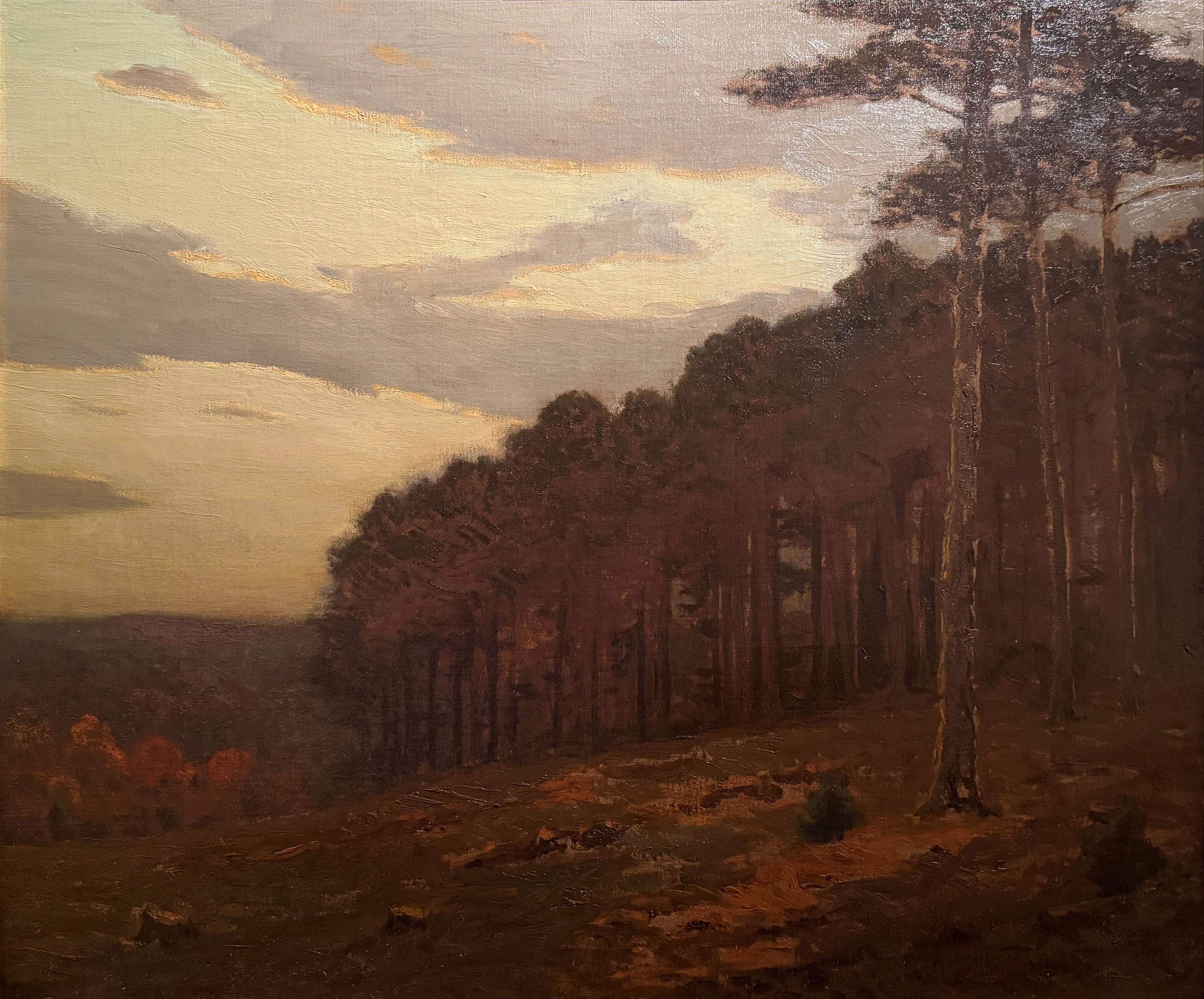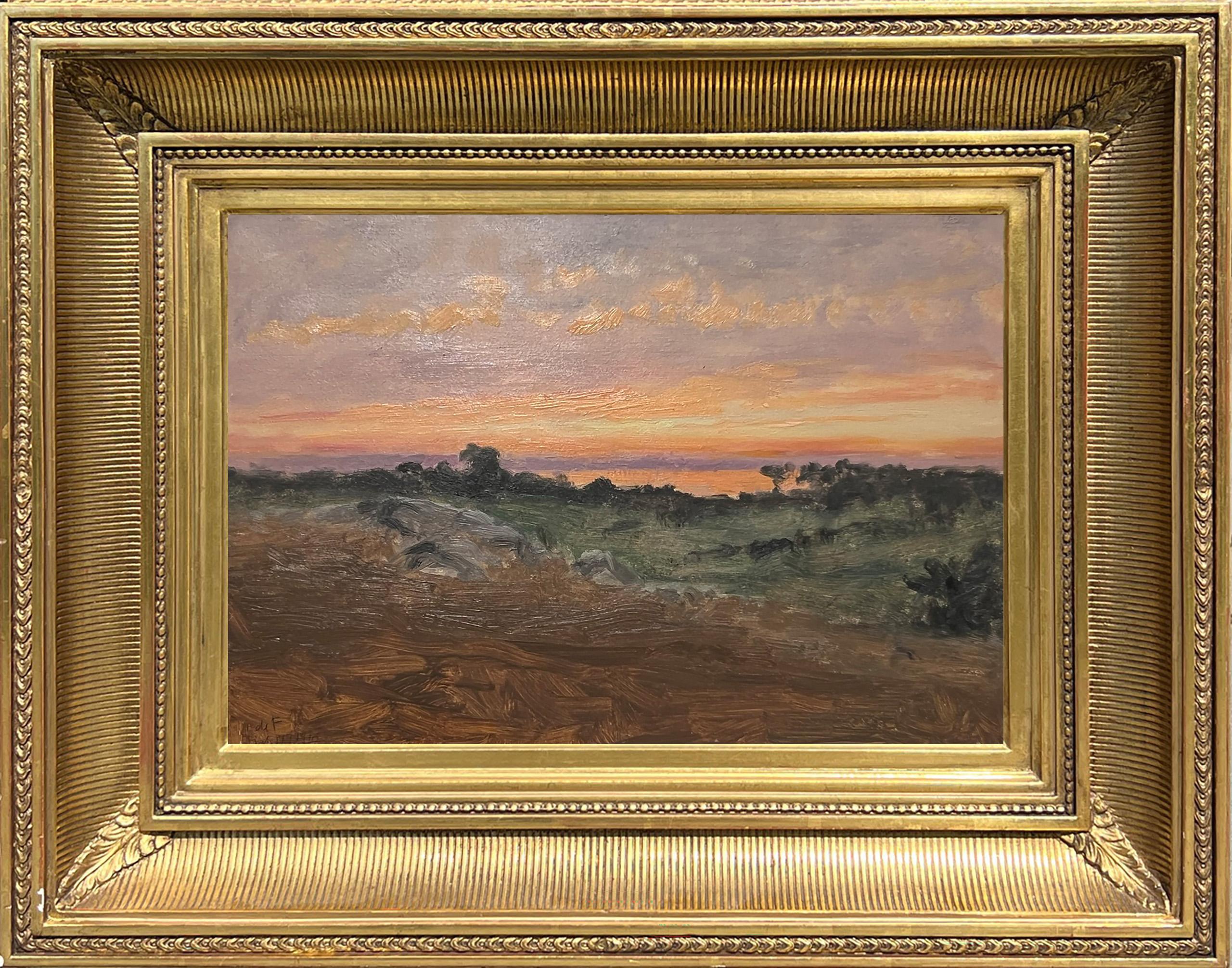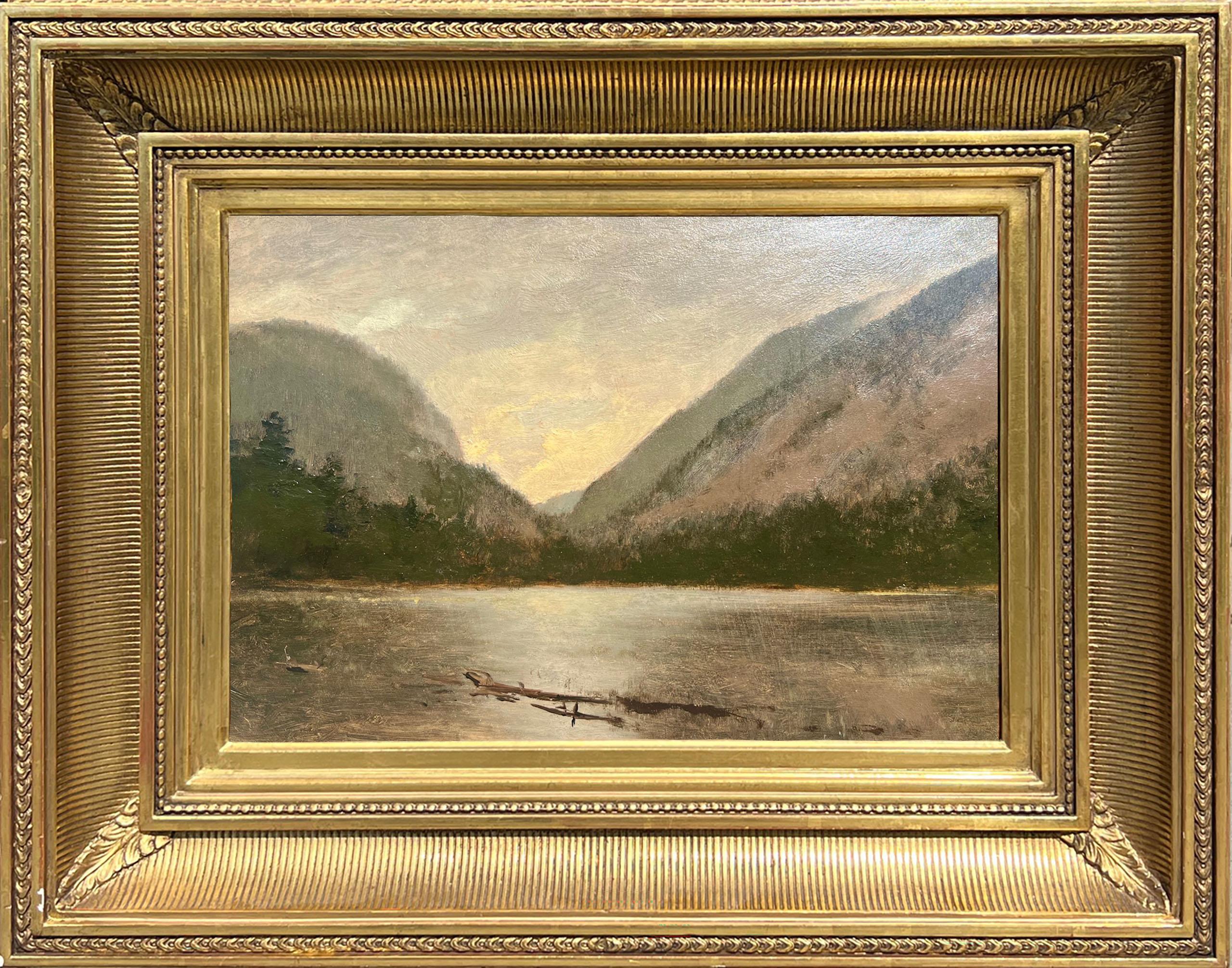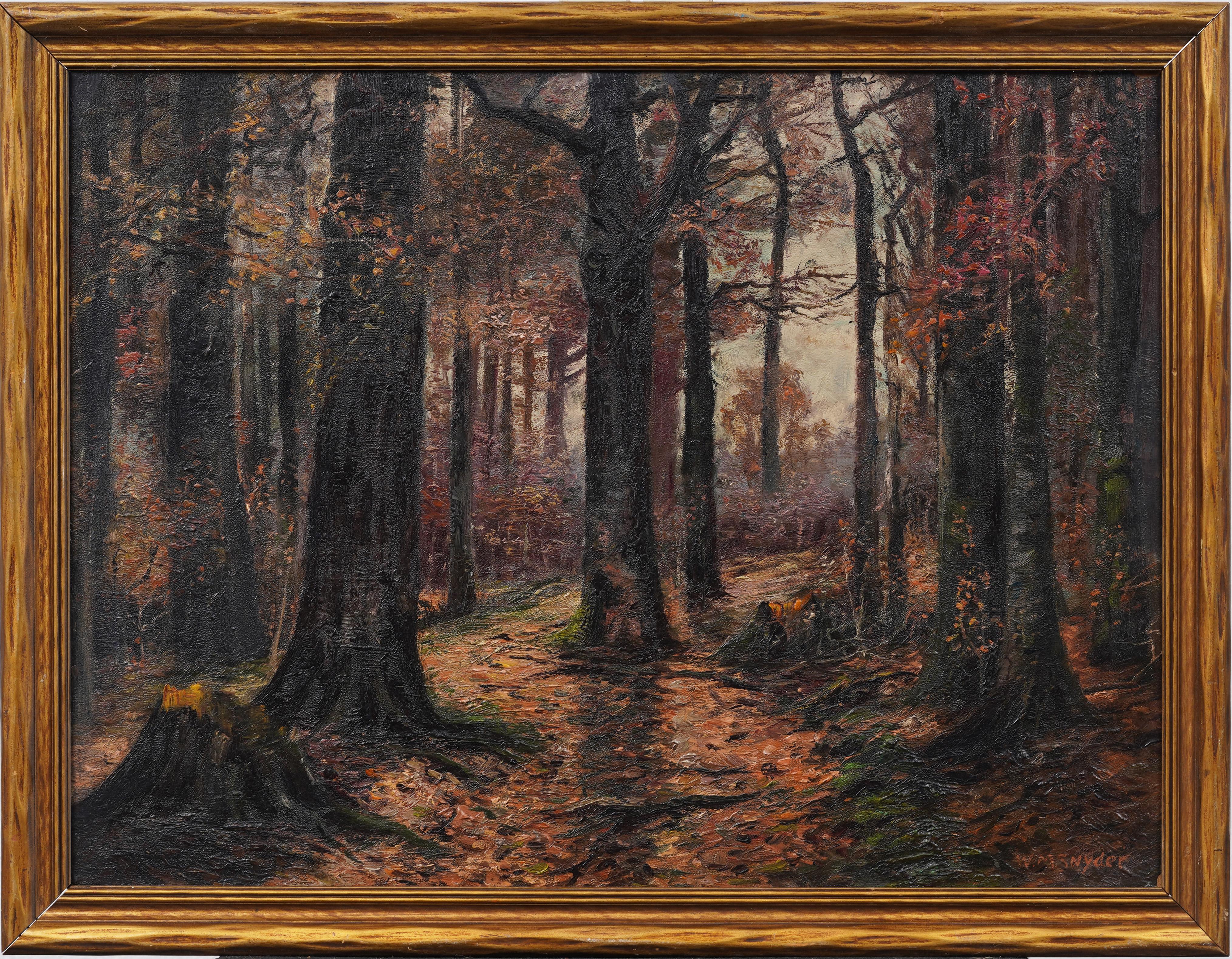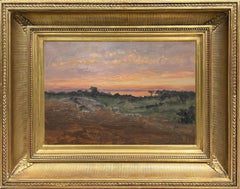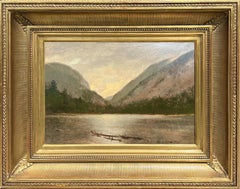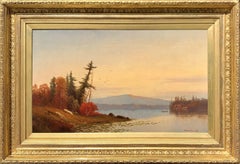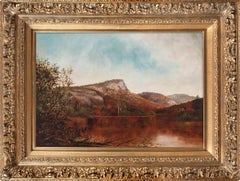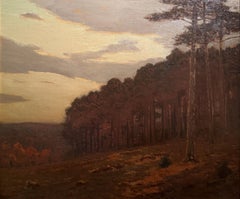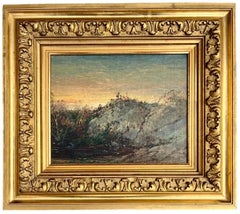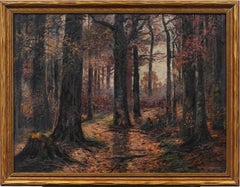Items Similar to Dusk Forest Scene, Catskills by Lockwood DeForest (American, 1850-1932)
Want more images or videos?
Request additional images or videos from the seller
1 of 6
Lockwood DeForestDusk Forest Scene, Catskills by Lockwood DeForest (American, 1850-1932)1875
1875
$9,500
£7,148.55
€8,264.26
CA$13,414.27
A$14,545
CHF 7,718.86
MX$179,140.17
NOK 95,670.41
SEK 90,290.87
DKK 61,686.49
About the Item
"Dusk Forest Scene, Catskills," 1875 by Hudson River School painter Lockwood DeForest (American, 1850-1932) is oil on artists card-stock and measures 9.5 x 7 inches. The work is signed by DeForest, and dated May 13, 1875 at lower right. The work is framed in an elegant, period appropriate frame, and ready to hang.
Lockwood de Forest was born in New York in 1850 to a prominent family. He grew up in Greenwich Village and on Long Island at the family summer estate in Cold Spring Harbor. As was customary for a cultivated family in the Gilded Age, the de Forests made frequent trips abroad. Excursions to the great museums, which were prominent on the de Forests agenda, deepened the young Lockwood's familiarity with European painting and sculpture. Though he had begun drawing and painting somewhat earlier, it was during a visit to Rome in 1868 that nineteen-year-old de Forest first began to study art seriously, taking painting lessons from the Italian landscapist Hermann David Salomon Corrodi (1844–1905). More importantly, on the same trip, Lockwood met one of America’s most celebrated painters, (and his maternal great-
uncle by marriage) Frederic Edwin Church (1826–1900), who quickly became his mentor. DeForest accompanied Church on sketching trips around Italy and continued this practice when they both returned to America in 1869. Early on in his career, de Forest made a habit of recording the date and often the place of his oil sketches, as to create a visual diary of his travels. Lockwood’s profession as a landscape painter can be primarily attributed to Frederic E. Church and his belief in the young artist’s talent.
De Forest often visited Church in the Hudson River community of Catskill where, in addition to sketching trips and afternoons of painting, he assisted with the architectural drawings and planning of Olana. In 1872, de Forest took a studio at the Tenth Street Studio Building in New York. During these formative years de Forest counted among his friend’s artists such as Sanford Robinson Gifford (1823–80), George Henry Yewell (1830–1923), John Frederick Kensett (1816–72), Jervis McEntee (1828–91), and Walter Launt Palmer (1854–1932).
Over the next decade de Forest experienced success as a painter. He exhibited for the first time at the National Academy of Design in 1872, and made two more painting trips abroad, in 1875–76 and 1877–78, traveling to the major continental capitals but also the Middle East and North Africa. His trip to the Middle East and the library at Church’s home, Olana, established his interest in design during his mid-twenties. From about 1878 to 1902, landscape painting was overshadowed by his activities and preoccupation with East Indian architecture and décor, a style that became quite fashionable in late nineteenth century America. From 1879-1883, de Forest founded Associated Artists along with Louis Comfort Tiffany, Candace Wheeler and Samuel Colman. Besides being patronized by the most prominent families in America, Associated Artists was commissioned to redecorate the White House in 1882.
While working in the decorating business, De Forest had continued to paint at home and wherever he traveled. He exhibited his work frequently at the Century Club and the National Academy of Design. In 1898, de Forest was made a full member of the Academy. After spending many winters in Santa Barbara, California around 1889, de Forest built a house and moved there permanently in 1922. De Forest created hundreds of oil sketches of Californian sites and also
traveled to the Pacific Northwest (1903), Maine (1905 and 1908), the Grand Canyon (1906 and 1909), Mexico (1904, 1906–7 and 1911), Massachusetts (1910), and Alaska (1912). Lockwood de Forest died in Santa Barbara in 1932.
- Creator:Lockwood DeForest (1850 - 1932, American)
- Creation Year:1875
- Dimensions:Height: 9.5 in (24.13 cm)Width: 7 in (17.78 cm)
- Medium:
- Movement & Style:
- Period:
- Condition:
- Gallery Location:New York, NY
- Reference Number:1stDibs: LU2151214827202
About the Seller
5.0
Recognized Seller
These prestigious sellers are industry leaders and represent the highest echelon for item quality and design.
Established in 2004
1stDibs seller since 2022
5 sales on 1stDibs
- ShippingRetrieving quote...Shipping from: New York, NY
- Return Policy
Authenticity Guarantee
In the unlikely event there’s an issue with an item’s authenticity, contact us within 1 year for a full refund. DetailsMoney-Back Guarantee
If your item is not as described, is damaged in transit, or does not arrive, contact us within 7 days for a full refund. Details24-Hour Cancellation
You have a 24-hour grace period in which to reconsider your purchase, with no questions asked.Vetted Professional Sellers
Our world-class sellers must adhere to strict standards for service and quality, maintaining the integrity of our listings.Price-Match Guarantee
If you find that a seller listed the same item for a lower price elsewhere, we’ll match it.Trusted Global Delivery
Our best-in-class carrier network provides specialized shipping options worldwide, including custom delivery.More From This Seller
View AllNew England Sunrise, 1910 by Lockwood DeForest (American, 1850-1932)
Located in New York, NY
"New England Sunrise," 1910 by Hudson River School painter Lockwood DeForest (American, 1850-1932) is oil on artists card-stock and measures 9.75 x 14 inches. The work is signed by DeForest and dated Sept. 17, 1910 at lower left. The work is framed in an elegant, period appropriate frame, and ready to hang.
Lockwood de Forest was born in New York in 1850 to a prominent family. He grew up in Greenwich Village and on Long Island at the family summer estate in Cold Spring Harbor. As was customary for a cultivated family in the Gilded Age, the de Forests made frequent trips abroad. Excursions to the great museums, which were prominent on the de Forests agenda, deepened the young Lockwood's familiarity with European painting and sculpture. Though he had begun drawing and painting somewhat earlier, it was during a visit to Rome in 1868 that nineteen-year-old de Forest first began to study art seriously, taking painting lessons from the Italian landscapist Hermann David Salomon Corrodi (1844–1905). More importantly, on the same trip, Lockwood met one of America’s most celebrated painters, (and his maternal great-
uncle by marriage) Frederic Edwin Church (1826–1900), who quickly became his mentor. DeForest accompanied Church on sketching trips around Italy and continued this practice when they both returned to America in 1869. Early on in his career, de Forest made a habit of recording the date and often the place of his oil sketches, as to create a visual diary of his travels. Lockwood’s profession as a landscape painter can be primarily attributed to Frederic E. Church and his belief in the young artist’s talent.
De Forest often visited Church in the Hudson River community of Catskill where, in addition to sketching trips and afternoons of painting, he assisted with the architectural drawings and planning of Olana. In 1872, de Forest took a studio at the Tenth Street Studio Building in New York. During these formative years de Forest counted among his friend’s artists such as Sanford Robinson Gifford (1823–80), George Henry Yewell (1830–1923), John Frederick Kensett (1816–72), Jervis McEntee (1828–91), and Walter Launt Palmer (1854–1932).
Over the next decade de Forest experienced success as a painter. He exhibited for the first time at the National Academy of Design in 1872, and made two more painting trips abroad, in 1875–76 and 1877–78, traveling to the major continental capitals but also the Middle East and North Africa. His trip to the Middle East and the library at Church’s home, Olana, established his interest in design during his mid-twenties. From about 1878 to 1902, landscape painting was overshadowed by his activities and preoccupation with East Indian architecture and décor, a style that became quite fashionable in late nineteenth century America. From 1879-1883, de Forest founded Associated Artists along with Louis Comfort Tiffany, Candace Wheeler...
Category
Early 20th Century Hudson River School Landscape Paintings
Materials
Oil, Board
Hudson Highlands by Lockwood DeForest (American, 1850-1932)
Located in New York, NY
"Hudson Highlands," by Hudson River School painter Lockwood DeForest (American, 1850-1932) is oil on artists card-stock and measures 9.5 x 14 inches. The work is framed in an elegant, period appropriate frame, and ready to hang.
Lockwood de Forest was born in New York in 1850 to a prominent family. He grew up in Greenwich Village and on Long Island at the family summer estate in Cold Spring Harbor. As was customary for a cultivated family in the Gilded Age, the de Forests made frequent trips abroad. Excursions to the great museums, which were prominent on the de Forests agenda, deepened the young Lockwood's familiarity with European painting and sculpture. Though he had begun drawing and painting somewhat earlier, it was during a visit to Rome in 1868 that nineteen-year-old de Forest first began to study art seriously, taking painting lessons from the Italian landscapist Hermann David Salomon Corrodi (1844–1905). More importantly, on the same trip, Lockwood met one of America’s most celebrated painters, (and his maternal great-
uncle by marriage) Frederic Edwin Church (1826–1900), who quickly became his mentor. DeForest accompanied Church on sketching trips around Italy and continued this practice when they both returned to America in 1869. Early on in his career, de Forest made a habit of recording the date and often the place of his oil sketches, as to create a visual diary of his travels. Lockwood’s profession as a landscape painter can be primarily attributed to Frederic E. Church and his belief in the young artist’s talent.
De Forest often visited Church in the Hudson River community of Catskill where, in addition to sketching trips and afternoons of painting, he assisted with the architectural drawings and planning of Olana. In 1872, de Forest took a studio at the Tenth Street Studio Building in New York. During these formative years de Forest counted among his friend’s artists such as Sanford Robinson Gifford (1823–80), George Henry Yewell (1830–1923), John Frederick Kensett (1816–72), Jervis McEntee (1828–91), and Walter Launt Palmer (1854–1932).
Over the next decade de Forest experienced success as a painter. He exhibited for the first time at the National Academy of Design in 1872, and made two more painting trips abroad, in 1875–76 and 1877–78, traveling to the major continental capitals but also the Middle East and North Africa. His trip to the Middle East and the library at Church’s home, Olana, established his interest in design during his mid-twenties. From about 1878 to 1902, landscape painting was overshadowed by his activities and preoccupation with East Indian architecture and décor, a style that became quite fashionable in late nineteenth century America. From 1879-1883, de Forest founded Associated Artists along with Louis Comfort Tiffany, Candace Wheeler...
Category
19th Century Hudson River School Landscape Paintings
Materials
Oil, Board
Sunset on the Hudson River by Hermann Simon (American, 1846-1895)
Located in New York, NY
Painted by Hudson River School artist Hermann Simon (1846-1895) , "Sunset on the Hudson River" is oil on canvas, measures 15 x 25 inches, and is signed and dated 1875 at the lower ri...
Category
19th Century Hudson River School Landscape Paintings
Materials
Canvas, Oil
View of South Pond, New York, 1879 by Ida H. Stebbins (American, b. 1851)
Located in New York, NY
Painted by Hudson River School artist Ida H. Stebbins (b. 1851), "View of South Pond, New York," 1879 is oil on canvas, measures 23 x 33 1/2 inches, and is signed and dated 1879 at the lower left. The work is framed in an elegant Barbizon style frame and ready to hang.
Ida H. Stebbins was born in January 1851 in Chelsea, Massachusetts to Mary and Isaac Stebbins, a teacher. Though scant records remain of Stebbins’ artistic training or career, various personal details of her life have been gleaned from contemporary newspapers and federal documents. By the time View of South Pond, New York was painted in 1879, she was living in Boston. Like many artists of her generation, Stebbins likely traveled throughout the Northeast region, gaining inspiration for her paintings from the landscape of New England and New York. Stebbins was likely visiting
upstate New York when she painted this sweeping view of South Pond and the surrounding mountains near Long Lake in the Adirondacks just south of Deerland. Here, Stebbins captures the stunning vermillion, burnt orange and brown tones of the autumn landscape with the style and precise rendering often seen in paintings produced by the Hudson River School.
Shortly after the completion of View of South Pond, New York, Stebbins married Frank H. Slack, a clerk, in her hometown of Chelsea on December 14, 1881 at the age of thirty. The couple moved to Hotel Comfort in Boston, where their son, Roland Stewart Slack was born on May 22, 1883. It seems likely that her husband died in the mid-1880s since on December 3, 1889, records indicate that Ida and Roland changed their last name back to her maiden name of Stebbins.
Roland Stewart Stebbins (1883-1974) inherited his mother’s interest in art, studying at the Pennsylvania Academy of the Fine Arts, Columbia University in New York, and the Art Students League of New York. He also studied at the Académie de la Grand Chaumière and the Munich Academy of Fine Arts. Today, he is remembered for his marine and genre paintings and for his legacy as a respected professor of art education at the University of Wisconsin, Madison.
On January 1, 1890, Ida married her second husband, Timothy Jarvis, in Somerville, Massachusetts. Their daughter, Ida Hazel Jarvis, was born soon after in 1893. However, the child suffered paralysis from a brain tumor...
Category
19th Century Hudson River School Landscape Paintings
Materials
Canvas, Oil
Scene in the White Mountains by Alfred Thompson Bricher (American, 1837-1908)
By Alfred Thompson Bricher
Located in New York, NY
Painted by Hudson River School artist Alfred Thompson Bricher (1837-1908) , "Scene in the White Mountains" is oil on panel, measures 5.5 x 9.75 inches, and is signed and dated 1864 a...
Category
19th Century Hudson River School Landscape Paintings
Materials
Oil, Panel
Autumn Landscape (NH) by Hudson River artist Henry A. Ferguson (1845-1911)
Located in New York, NY
Painted by Hudson River School artist Henry A. Ferguson (1845-1911), "Autumn Landscape (NH)" is oil on canvas and measures 9 x 15 inches. The painting is signed and dated 1864, at th...
Category
19th Century Hudson River School Landscape Paintings
Materials
Canvas, Oil
You May Also Like
"Autumn, New England" Charles Warren Eaton, Tonalist Gloaming Sunset in Woods
By Charles Warren Eaton
Located in New York, NY
Charles Warren Eaton
Autumn, New England
Signed lower right
Oil on canvas
30 x 36 inches
Provenance
Private Collection, Connecticut
A contemporary critic wrote that the paintings o...
Category
Early 1900s Tonalist Figurative Paintings
Materials
Canvas, Oil
Henry Ward Ranger Connecticut Landscape Oil Painting 1858–1916 American Tonalist
By Henry Ward Ranger
Located in Chesterfield, NJ
Henry Ward Ranger
Connecticut Landscape
oil/panel 12 x 16 image size 21 3/8 x 25 3/8 x 2 3/4 framed
A wonderful example of Rangers painting style of glazes and areas of impasto text...
Category
20th Century Tonalist Landscape Paintings
Materials
Oil
Twilight in the Hills
By William Louis Sonntag Sr. 1
Located in Wiscasett, ME
A luminous Autumn oil on canvas board landscape, probably of the hills in the Hudson River Valley, by the noted American artist William Louis Sonntag (1822-1900). Signed in the lower right. Sonntag was born near Pittsburgh, PA and moved to Cincinnati, OH in the 1840’s to study art. He studied for a brief time with G. Frankenstein at the Cincinnati Academy of Fine Art and his idealized paintings of American wilderness and visionary paintings of imagined European ruins were commercially successful. He traveled twice to Europe in the 1850’s to improve his skills, eventually settling in New York City. He joined the National Academy of Design, where he exhibited his works for forty years. His mature works identify him with the Hudson River School of landscape painters. A romantic and naturalistic painter of his surroundings, Sonntag also created idealized paintings of Roman ruins, recalling his European trips of earlier years. Sonntag was an Associate (1860) and Academician (1861) at the National Academy of Design, and a member of the American Watercolor Society, Artists Fund Society, and the American Art Union...
Category
19th Century Hudson River School Landscape Paintings
Materials
Oil
Listed Antique American Impressionist Indiana Forest Interior Framed Painting
Located in Buffalo, NY
Impressive early American impressionist forest interior landscape oil painting by William McKendree Snyder (1848 - 1930). Framed. Oil on board. Signed. Image size, 18H by 24L.
Category
1910s Impressionist Landscape Paintings
Materials
Canvas, Oil
Late 19th Century Landscape at Dusk by American Impressionist
By Charles Courtney Curran
Located in Beachwood, OH
Charles Courtney Curran (American, 1861-1942)
Landscape at Dusk, 1888
Oil on canvas
Signed lower left
18 x 22 inches
24.5 x 28.75 inches, framed
Charles Courtney Curran was born in ...
Category
1880s American Impressionist Landscape Paintings
Materials
Oil
Oil Sunset Forest Scene titled "Autumn Sunset"
Located in Fredericksburg, VA
Paul Gottlieb Weber (1823-1916) was a German-American painter renowned for his landscape and genre scenes. Settling initially in Philadelphia from Germany, he quickly gained recognit...
Category
Mid-19th Century Hudson River School Landscape Paintings
Materials
Canvas, Oil
More Ways To Browse
Artist Robinson
19th Century Continental School Painting
19th Century Painting Continental School Painting
Antique Architectural Plans
Frederic Church
Catskills Painting
Salomon Corrodi
Cypress Trees Painting
Dutch Boats
Eucalyptus Tree
Eugene Galien Laloue
French Countryside Oil Painting
Mid Century Marine Art
Norwegian Painters
Paris Painting Montmartre
Peter Eugene Ball
R Thomas
Schmidt Oil Painting
